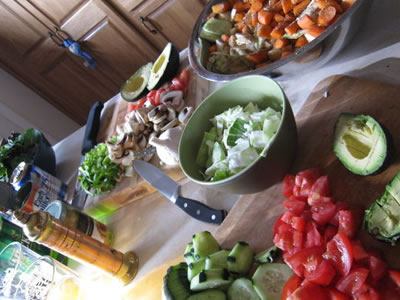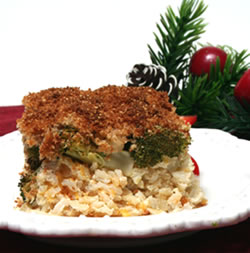What comes to mind when you think of a clean kitchen? Shiny waxed floors? Gleaming stainless steel sinks? Spotless counters and neatly arranged cupboards?
They can help, but a truly “clean” kitchen–that is, one that ensures safe food–relies on more than just looks: It also depends on safe food practices.
In the home, food safety concerns revolve around three main functions: food storage, food handling, and cooking. To see how well you’re doing in each, take this quiz, and then read on to learn how you can make the meals and snacks from your kitchen the safest possible.
Take The Quiz
Choose the answer that best describes the practice in your household, whether or not you are the primary food handler.
- The temperature of the refrigerator in my home is:
a. 50 degrees Fahrenheit (10 degrees Celsius)
b. 41 F (5 C)
c. I don’t know; I’ve never measured it. - The last time we had leftover cooked stew or other food with meat, chicken or fish, the food was:
a. cooled to room temperature, then put in the refrigerator
b. put in the refrigerator immediately after the food was served
c. left at room temperature overnight or longer - The last time the kitchen sink drain, disposal and connecting pipe in my home were sanitized was:
a. last night
b. several weeks ago
c. can’t remember - If a cutting board is used in my home to cut raw meat, poultry or fish and it is going to be used to chop another food, the board is:
a. reused as is
b. wiped with a damp cloth
c. washed with soap and hot water and sanitized with a mild chlorine bleach solution - The last time we had hamburgers in my home, I ate mine:
a. rare
b. medium
c. well-done - The last time there was cookie dough in my home, the dough was:
a. made with raw eggs, and I sampled some of it
b. store-bought, and I sampled some of it
c. not sampled until baked - I clean my kitchen counters and other surfaces that come in contact with food with:
a. water
b. hot water and soap
c. hot water and soap, then bleach solution
d. hot water and soap, then commercial sanitizing agent - When dishes are washed in my home, they are:
a. cleaned by an automatic dishwasher and then air-dried
b. left to soak in the sink for several hours and then washed with soap in the same water
c. washed right away with hot water and soap in the sink and then air-dried
d. washed right away with hot water and soap in the sink and immediately towel-dried - The last time I handled raw meat, poultry or fish, I cleaned my hands afterwards by:
a. wiping them on a towel
b. rinsing them under hot, cold or warm tap water
c. washing with soap and warm water - Meat, poultry and fish products are defrosted in my home by:
a. setting them on the counter
b. placing them in the refrigerator
c. microwaving
Answers To The Quiz
- Refrigerators should stay at 41 F (5 C) or less, so if you chose answer B, give yourself two points. If you didn’t, you’re not alone. According to Joseph Madden, Ph.D., strategic manager for microbiology in the Food and Drug Administration’s Center for Food Safety and Applied Nutrition, many people overlook the importance of maintaining an appropriate refrigerator temperature.
“According to surveys, in many households, the refrigerator temperature is above 50 degrees (10 C),” he said.
His advice: Measure the temperature with a thermometer and, if needed, adjust the refrigerator’s temperature control dial.
A temperature of 41 F (5 C) or less is important because it slows the growth of most bacteria. The temperature won’t kill the bacteria, but it will keep them from multiplying, and the fewer there are, the less likely you are to get sick from them.
Freezing at zero F (minus 18 C) or less stops bacterial growth (although it won’t kill all bacteria already present).
- Answer B is the best practice; give yourself two points if you picked it.Hot foods should be refrigerated as soon as possible within two hours after cooking. But don’t keep the food if it’s been standing out for more than two hours. Don’t taste test it, either. Even a small amount of contaminated food can cause illness.Date leftovers so they can be used within a safe time. Generally, they remain safe when refrigerated for three to five days. If in doubt, throw it out, says former FDA microbiologist Jeffery Rhodehamel, now with W.R. Grace and Co.. “It’s not worth a food-borne illness for the small amount of food usually involved.”
- If answer A best describes your household’s practice, give yourself two points. Give yourself one point if you chose B.According to FDA’s Madden, the kitchen sink drain, disposal and connecting pipe are often overlooked, but they should be sanitized periodically by pouring down the sink a solution of 1 teaspoon (5 milliliters) of chlorine bleach in 1 quart (about 1 liter) of water or a solution of commercial kitchen cleaning agent made according to product directions. Food particles get trapped in the drain and disposal and, along with the moistness, create an ideal environment for bacterial growth.
- If answer C best describes your household’s practice, give yourself two points. Washing with soap and hot water and then sanitizing with a mild bleach solution is the safest practice, said Dhirendra Shah, Ph.D., director of the division of microbiological studies in FDA’s Center for Food Safety and Applied Nutrition.If you picked A, you’re violating an important food safety rule: Never allow raw meat, poultry and fish to come in contact with other foods. Answer B isn’t good, either. Improper washing, such as with a damp cloth, will not remove bacteria.
- Give yourself two points if you picked answer C.The safest way to eat hamburgers is to cook them until they are no longer red in the middle and the juices run clear. That doesn’t happen with rare-cooked meats, and it may not happen with medium-cooked ones. Cooking food, including ground meat patties, to an internal temperature of at least 160 F (71 C) usually protects against food-borne illness. Well-done meats reach that temperature.To be on the safe side, check cooked meat, fish and poultry with a meat thermometer to ensure that they have reached a safe internal temperature.For microwaved food, follow directions, including the standing time, either in or out of the microwave, after cooking. Microwave cooking creates pockets of heat in the food, but allowing the food to stand before eating allows the heat to spread to the rest of the food.
- If you answered A, you may be putting yourself at risk for infection with Salmonella enteritidis, a bacterium that can be in shell eggs. Cooking the egg or egg-containing food product to at least 140 F (60 C) kills the bacteria. So answer C–eating the baked product–will earn you two points.You’ll get two points for answer B, also. Foods containing raw eggs, such as homemade ice cream, cake batter, mayonnaise, and eggnog, carry a Salmonella risk, but their commercial counterparts don’t. Commercial products are made with pasteurized eggs; that is, eggs that have been heated sufficiently to kill bacteria, and also may contain an acidifying agent that kills the bacteria. Commercial preparations of cookie dough are not a food hazard.If you want to sample homemade dough or batter or eat other foods with raw-egg-containing products, consider substituting pasteurized eggs for raw eggs. Pasteurized eggs are usually sold in the grocer’s refrigerated dairy case.
- Answers C or D will earn you two points each; answer B, one point. According to FDA’s Madden, bleach and commercial kitchen cleaning agents are the best sanitizers–provided they’re diluted according to product directions. They’re the most effective at getting rid of bacteria. Hot water and soap does a good job, too, but may not kill all strainssponges clean because, when wet, these materials harbor bacteria and may promote their growth.
- Answers A and C are worth two points each. There are potential problems with B and D. When you let dishes sit in water for a long time, it “creates a soup,” FDA’s Madden said. “The food left on the dish contributes nutrients for bacteria, so the bacteria will multiply.” When washing dishes by hand, he said, it’s best to wash them all within two hours. Also, it’s best to air-dry them so you don’t handle them while they’re wet.
- The only correct practice is answer C. Give yourself two points if you picked it.Wash hands with warm water and soap for at least 20 seconds before and after handling food, especially raw meat, poultry and fish. If you have an infection or cut on your hands, wear rubber or plastic gloves. Wash gloved hands just as often as bare hands because the gloves can pick up bacteria. (However, when washing gloved hands, you don’t need to take off your gloves and wash your bare hands, too.)
- Give yourself two points if you picked B or C. Food safety experts recommend thawing foods in the refrigerator or the microwave oven or putting the package in a water-tight plastic bag submerged in cold water and changing the water every 30 minutes. Changing the water ensures that the food is kept cold, an important factor for slowing bacterial growth that may occur on the outer thawed portions while the inner areas are still thawing.When microwaving, follow package directions. Leave about 2 inches (about 5 centimeters) between the food and the inside surface of the microwave to allow heat to circulate. Smaller items will defrost more evenly than larger pieces of food. Foods defrosted in the microwave oven should be cooked immediately after thawing.Do not thaw meat, poultry and fish products on the counter or in the sink without cold water; bacteria can multiply rapidly at room temperature.
Rating Your Home’s Food Practices
20 points: Feel confident about the safety of foods served in your home.
12 to 19 points: Reexamine food safety practices in your home. Some key rules are being violated.
11 points or below: Take steps immediately to correct food handling, storage and cooking techniques used in your home. Current practices are putting you and other members of your household in danger of food-borne illness.
Home-Based Food-Borne Illness
When several members of a household come down with sudden, severe diarrhea and vomiting, intestinal flu is often considered the likely culprit. But food poisoning may be another consideration.
A true diagnosis is often never made because the ill people recover without having to see a doctor.
Health experts believe this is a common situation in households across the country, and because a doctor is often not seen for this kind of illness, the incidence of food-borne illness is not really known.
A task force of the Council for Agricultural Science and Technology, a private organization of food science groups, estimated in 1994 that 6.5 million to 33 million cases of food-borne illness occur in the United States each year. While many reported cases stem from food prepared by commercial or institutional establishments, sporadic cases and small outbreaks in homes are considered to be far more common, according to the April 1995 issue of Food Technology.
Cases of home-based food-borne illness may become a bigger problem, some food safety experts say, partly because today’s busy family may not be as familiar with food safety issues as more home-focused families of past generations.
A 1993 FDA survey found that men respondents tended to be less safe about food practices than women respondents and that respondents younger than 40 tended to be less safe than those over 40.
For example, when asked if they believed that cooked food left at room temperature overnight is safe to eat without reheating–a very unsafe practice–12 percent of the men respondents (but only 5 percent of the women respondents) said yes.
And, in looking at age differences, the survey found that nearly 40 percent of respondents younger than 40 indicated they did not adequately wash cutting boards, while only 25 percent of those 60 and over indicated the same.
The increased use of convenience foods, which often are preserved with special chemicals and processes, also complicates today’s home food safety practices, said Joseph Madden, Ph.D., strategic manager for microbiology in FDA’s Center for Food Safety and Applied Nutrition. These foods, such as TV dinners, which are specially preserved, give consumers a false idea that equivalent home-cooked foods are equally safe, he said.
To curb the problem, food safety experts recommend food safety education that emphasizes the principles of HACCP (Hazard Analysis Critical Control Point), a new food safety procedure that many food companies are now incorporating into their manufacturing processes. Unlike past practices, HACCP focuses on preventing food-borne hazards, such as microbial contamination, by identifying points at which hazardous materials can be introduced into the food and then monitoring these potential problem areas. (See HACCP: Patrolling for Food Hazards in the January-February 1995 FDA Consumer.)
“It’s mainly taking a common-sense approach towards food safety in the home,” said FDA microbiologist Jeffery Rhodehamel.
“Basically, consumers need to make sure they’re not defeating the system by contaminating the product.”
Other Kitchen Contaminants
Lead
Lead leached from some types of ceramic dinnerware into foods and beverages is often consumers’ biggest source of dietary lead, says John Jones, Ph.D., strategic manager for pesticides and chemical contaminants in FDA’s Center for Food Safety and Applied Nutrition. (See “Lead Threat Lessens, But Mugs Pose Problem” in the April 1993 FDA Consumer and “An Unwanted Souvenir: Lead in Ceramic Ware” in the December 1989-January 1990 FDA Consumer.) Here are some tips to reduce your exposure:
- Don’t store acidic foods, such as fruit juices, in ceramic containers.
- Avoid or limit to special occasions the use of antique or collectible housewares for food and beverages.
- Follow label directions on ornamental ceramic products labeled “Not for Food Use–May Poison Food” or “For Decorative Purposes Only,” and don’t use these items for preparing or storing food.
Also, don’t store beverages in lead crystal containers for extended periods.
Microwave Packaging
High temperature use of some microwave food packaging material may cause packaging components, such as paper, adhesives and polymers, to migrate into food at excessive levels. For that reason, choose only microwave-safe cooking containers. Never use packaging cartons for cooking unless the package directs you to do so.
Aluminum
According to FDA’s Jones, there has been speculation linking aluminum to Alzheimer’s disease. The link has never been proved, he said, but if consumers are concerned, they should avoid cooking acidic foods, such as tomato sauce, in aluminum pans. For other uses, well-maintained aluminum pans–as well as stainless steel, copper and iron pots and pans–present no apparent hazards.
Insect and Rodent Droppings, and Dirt
- Avoid storing food in cabinets that are under the sink or have water, drain and heating pipes passing through them. Food stored here can attract insects and rodents through openings that are difficult to seal adequately.
- Wash the tops of cans with soap and water before opening.











